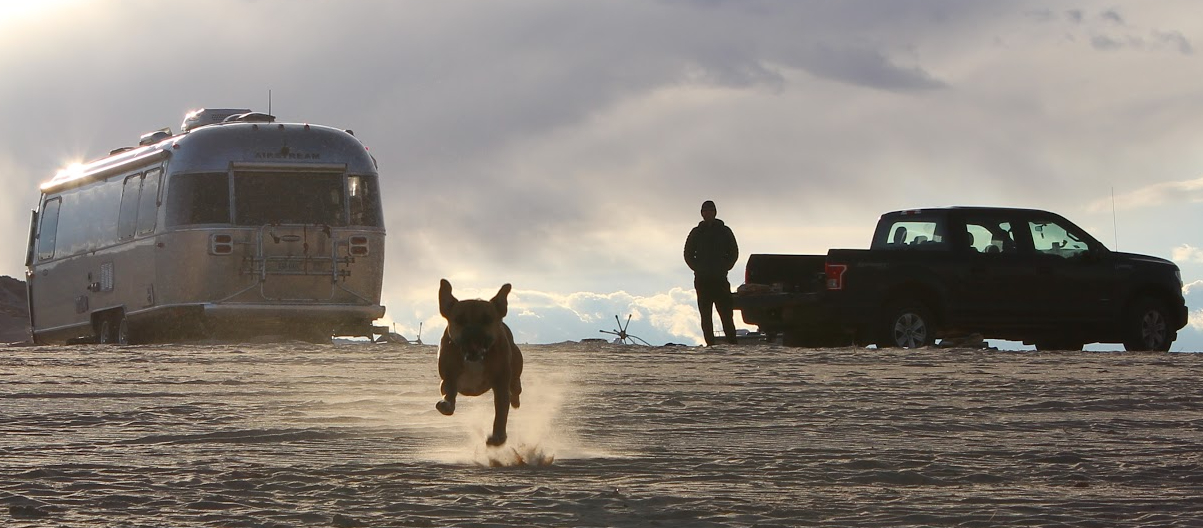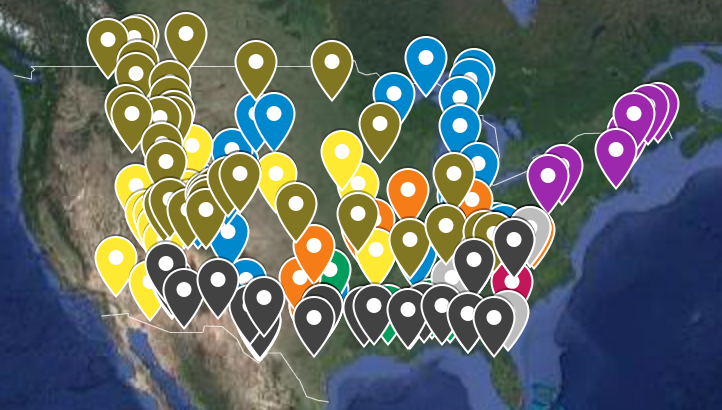We were in Alamogordo at the beginning of November 2022, as part of Big Trip #4.

Heading east from Tucson, you can’t not stop at White Sands National Park. Well, you CAN not stop–we’ve driven past it twice now and not stopped, thinking what’s the big deal about sand dunes, we’ve seen them before, and hiking in sand is the worst. Silly us! White Sands is gorgeous, dog-friendly, and we loved the hike we did across hard-packed sand.

Alamogordo is the city outside the national park, and like many places in the Desert Southwest, it was inhabited by Apaches before the Spanish showed up and built a church. The city was founded in 1898 to support the railroad, and the area became a center for air and space technology: there’s space shuttle pilot training at White Sands Space Harbor, weapons testing at White Sands Missle Range (where the first atomic bomb was test detonated in 1945), and pilot training and new equipment testing at Holloman Air Force Base.

Fun fact about Alamorgordo: in 1983, an Alamogordo landfill was the site of a mass burying of unsold Atari game cartridges, due to over-production and poor reception of new games. Around 700,000 cartridges of various games including E.T. the Extra-Terrestrial (often called the worst video game of all time) were driven from the El Paso Atari plant and crushed and buried in the landfill, then covered with a layer of concrete to prevent scavenging. Atari down-played the dumping by saying they were all broken, unusable cartridges, but they were actually struggling with serious financial difficulties at the time. In 2014 the city granted permission to a film company to excavate the site for a documentary, and about 1178 cartridges were recovered. Some were auctioned off by the city to raise funds for a memorial, with one E.T. cartridge selling for over $1500, and one E.T. cartridge went to the Smithsonian.

We didn’t see any old Atari cartridges in Alamogordo, unfortunately, but we did see some other cool stuff.
Campground

We stayed at the Alamogordo/White Sands KOA. Our spot was nice enough with a little table area and a privacy wall, and the campground offers sleds and wax for guests to borrow for sledding on the dunes (we didn’t go sledding, despite lots of people telling us it’s awesome).

For dinner, we stayed in the Airstream and ate the salads we picked up from Boca in Tucson, and I drank one of my favorite beers in recent memory, a rose and pistachio sour from Tucson’s Crooked Tooth Brewing, that I picked up at Westbound in the MSA Annex.
Activities

We did three activities in Alamogordo, and I’ll rank them in order of most to least enjoyment. Spoiler: if you can’t tell from the photos, White Sands was incredible.
White Sands National Park

The world’s largest gypsum dunefield, protected by White Sands National Park, is twenty miles from Alamogordo. The park has a scenic drive, several hiking trails, and sledding. Yes, you can sled down the dunes; they recommend a waxed plastic saucer, sold at the visitor center (or borrowed from your campground). When we drove past the visitor center in the early morning we saw a bunch of sleds out front that people had left the night before, so you might score one for free, but you’ll want wax as sand isn’t slippery.

Dunes Drive reaches eight miles into the dunes; the last three miles are on hard-packed gypsum, which looks sketchy to drive on but is fine for any vehicle. The park has five trails, and if you do any hiking, you should do the Alkali Flat trail, or at least a portion of it. It’s a five-mile dog-friendly tromp up, over, and through the dunes, and the scenery is spectacular. There’s some deep sand, but mostly it’s hard-packed and a pleasant walk. Go early to beat the crowds!

Where did the dunes come from? I’m so glad you asked. Around 250 million years ago, this part of the Southwest was covered by the shallow Permian Sea. Over time, the sea level rose and fell, and during times of evaporation the concentration of calcium and sulfate increased to the point where the mineral gypsum could form in thick layers on the seafloor. About 70 million years ago, the collision of tectonic plates pushed the seafloor up into mountains, then about thirty million years ago the plates started pulling apart, creating basins.

A large lake, Lake Otero, was formed in the Tularosa Basin where White Sands currently sits. During the last Ice Age, a glacier capped a nearby mountain, and as the climate warmed, the runoff from the glacier carried dissolved gypsum from the mountain into Lake Otero. Lake Otero eventually dried up, leaving behind all that gypsum on the basin floor, and the wind started breaking it into sand and piling it into dunes 7,000-10,000 years ago.
PistachioLand

We absolutely had to see the world’s largest pistachio at PistachioLand, just a few minutes outside of town. They have RV parking, so we parked the Airstream and took pictures of Bugsy with the giant pistachio and went inside to eat a zillion samples–and buy a bunch of bags of all sorts of flavors of pistachios.

PistachioLand is pet-friendly, but you have to hold them, so Bugsy stayed in the Airstream. We didn’t participate in the wine tastings or farm tours. It was a fun stop!
We realized after our PistachioLand visit that Uncle Jim had recommended nearby Heart of the Desert Pistachios, but we were distracted by the giant pistachio and went to the wrong place.
A brewery
Alamogordo to Tucson should be a five-hour drive, but a bad wreck on I-10 (involving an RV–a scary reminder to be careful out there) made it seven hours. Maybe that put us in a negative state of mind, but we didn’t like 575 Brewing. It seemed like everyone else in town did, though, so they’ll be just fine. It was rocking on Friday night, and the dog-friendly patio was cute, but there was no room at the bar and we didn’t like the other seating options and the beer list wasn’t to our liking so we left.

We had scheduled two nights in Alamogordo, but after we got through our to-do list pretty quickly, we decided to move on and check out an old Route 66 town farther east, Tucumcari.






Leave a Reply